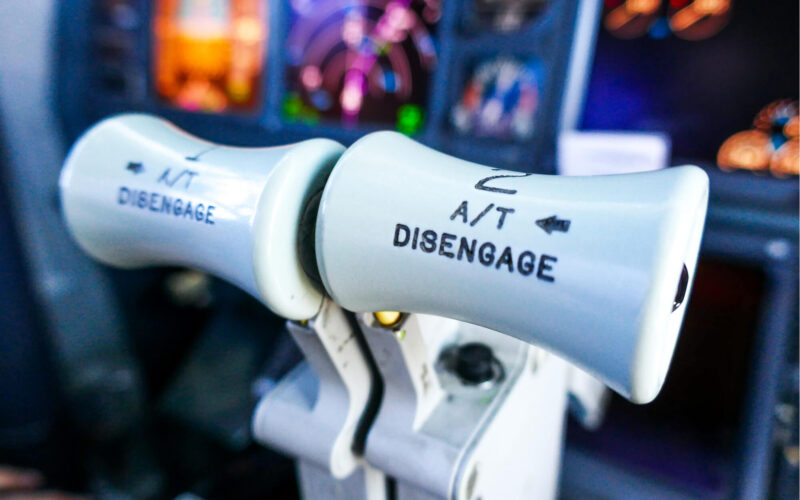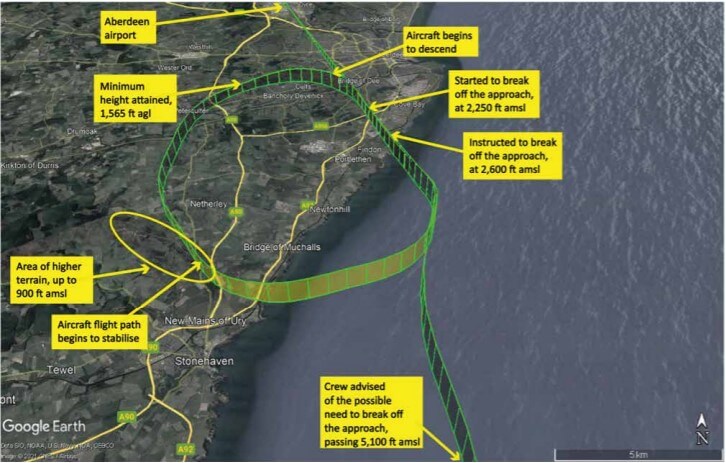Could a lack of flying practice due to the COVID-19 pandemic have contributed to a serious incident during a go-around at Aberdeen Airport (ABZ) in September 2021?
That’s what the UK’s Air Accidents Investigation Branch (AAIB) is considering. The AAIB issued a special bulletin on December 2, 2021 to highlight the issue after starting an investigation into the go-around incident on September 11, 2021.
The TUI Airways Boeing 737-800, aircraft registration G-FDZF, with 67 passengers and six crew on board, was flying to ABZ from Palma de Mallorca (PMI) when the incident occurred at approximately 1240 UTC.
During a go-around, instead of climbing and maintaining 3,000 feet, the aircraft deviated “significantly” from the expected flight path. Before reaching 3,000 ft the aircraft began to descend, reaching a minimum height of 1,565 ft above the ground.
“There was a high rate of descent, which was reducing the aircraft’s separation from terrain, and an uncommanded and undesirable increase in airspeed that were not corrected in a timely manner,” the AAIB stated in a special bulletin.
How is this related to COVID-19?
The AAIB noted that the crew of the incident flight, like many other pilots, had had substantial gaps in flying during the previous 18 months. With planes largely grounded as a result of travel restrictions, many pilots have lost their jobs or been placed on furlough measures.
Investigators said the captain had flown 10 flights during the previous month, but the co-pilot had flown just four flights in almost 11 months, with two flights with a trainer seven days before the day of the incident. Both pilots had carried out numerous simulator sessions during the 18-month period for recency or to complete their annual checks.
A Special Bulletin has been published concerning a serious incident involving a Boeing 737-800 aircraft registration G-FDZF, with 66 passengers on board, during a go-around at Aberdeen Airport on 11 September 2021.
— AAIB (@aaibgovuk) December 2, 2021
Read the report: https://t.co/E9bj6ieVFc pic.twitter.com/fMaCTNr5fW
The investigators said that while simulator training brings many benefits, it can be hard to replicate real-life flying situations. They acknowledged that airlines have faced challenges in keeping crew current during the pandemic. The AAIB also noted that regulators have been concerned that pilots may perform below their usual standards when returning to work after periods of grounding related to the pandemic.
“The real-world environment creates different demands on crews, and it is possible that this event illustrates that lack of recent exposure to the real-world environment can erode crews’ capacity to deal effectively with those challenges,” the AAIB wrote.
“Although this investigation has not established a link between this event and a lack of line flying, this Special Bulletin is published for awareness and because a link is clearly one possibility.”
What happened?
While on the approach to Runway 34, the crew were informed they may have to discontinue the landing due to a search and rescue helicopter which was preparing to depart, and which would take priority.
When they were at 2,600 ft above mean sea level, the crew were then told to discontinue the approach and instead climb to 3,000 ft and turn left to heading 270.
Before reaching 3,000 ft, however, the aircraft descended, accelerating past the speed limit of 250 knots below Flight Level 100. It took 57 seconds before a climb was re-established. A vertical descent rate of more than 3,000 ft/min and acceleration to 286 knots was also recorded before the flight path was corrected.
During the descent, air traffic controllers had passed further heading instructions to the crew. The tower controller noticed the descent and advised the radar controller to alert the crew. That call came just as the crew put the aircraft back into climb.
The event took place while the aircraft was in instrument meteorological conditions, indicating they were in clouds and unable to see the ground. A second approach and the subsequent landing were completed without incident.
Image: AAIB
What’s next?
The investigation is ongoing. The Special Bulletin contains facts determined so far but was also issued to raise awareness of the incident and “to highlight that go-arounds from intermediate altitudes on an approach can provoke errors because they are not practiced frequently.”
The AAIB said work would be undertaken to:
- Assess the impact of the lack of recent flying on the actions of the crew.
- Assess the effectiveness of the barriers to crews recognising that there has been a significant deviation from the expected flight path.
- Ensure the flight director behaved as expected.
- Consider the effect of ATC instructions during the go-around and, subsequently, during periods of high crew workload.
The AAIB said it was not making any specific recommendations at this stage of the investigation, adding that a final report would be published in due course.


